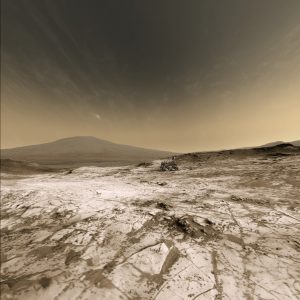For Intellectual Production #4 I observed my wife’s aunt (C) and uncle (L) during their first introduction to virtual reality. Their ages range between 65 and 70 with little-to-no exposure to video games of any kind. The session began with C trying the VR system first – donning the headset and launching into an exploration of Vesper Peak, WA through Valve’s VR Lab. The experience has players perched upon the peak of Mount Vesper in a 3D environment stitched together from photographs a Valve employee took on camping trip. The player can use the controllers to traverse the peak as well as interact with a virtual robotic dog. The play style is open-ended exploration and as Huizinga states “[t]o our way of thinking, play is the direct opposite of seriousness […] Examined more closely, however, the contrast between play and seriousness proves to be neither conclusive nor fixed. We can say: play is non-seriousness.” (2004, p. 101)
The Vesper Peak experience has no serious consequences, win conditions, or rules but merely allows the player to “[step] out of “real” life into a temporary sphere of activity with a disposition all of its own.” (Huizinga, 2004, p. 103) The immersion and reality brought about by the virtual reality experience elevates the game from a frivolous novelty as the fidelity delivered by the headset allows for in-depth investigation of the area which I would contend matches Huizinga’s claim that “some play can be very serious indeed.”( 2004, p. 101). The VR experience also is a paragon of the statement that:
“consciousness of play being “only a pretend” does not by any means prevent it from proceeding with the utmost seriousness, with an absorption, a devotion that passes into rapture and, temporarily at least, completely abolishes that troublesome “only” feeling.” (Huizinga, 2004, p. 103)
The experience was so realistic in fact it triggered C’s fear of heights prompting a change in environments to a lava tube in Iceland. I believe this is a prime example of how “players have a desire to play, and play the most absorbing, exhausting game in order to find diversion. escape from responsibility and routine. Finally and above all, it is necessary that they be free to leave whenever they please. by saying: “I am not playing any more.”” (Caillois, 2006, p. 125)
As C progressed through the experience we shifted her setting to Mars (Valve has rendered the environment based off photography and geological data passed on from the Curiosity Rover). In this environment C was able to take upon the role of an explorer of the red planet herself, traversing the area the rover had explored. This roleplaying allows players to experience gameplay which “presuppose free improvisation, and the chief attraction of which lies in the pleasure of playing a role” (Caillois, 2006, p. 126). I felt this also met many of Huizinga’s formal characteristics of play where the player was engaged in:
“a free activity standing quite consciously outside “ordinary” life as being “not serious.” but at the same time absorbing the player intensely and utterly, It is an activity connected with no material interest, and no profit can be gained by it. It proceeds within its own proper boundaries of time and space according to fixed rules and in an orderly manner.” (Huizinga, 2004, p. 107)
When it was L’s turn, due to a chronic condition, he was seated in a chair and navigated the environment of Mars purely through controller motion. The platform of video games allowed him to experience the environment in an accessible way where he was in total control of his interactions with the environment. He was delighted to bring his personal knowledge of geology as he inspected the fluvial patterns in the landscape of Mars and making hypotheses of the soil composition. In observing L’s experience I found myself in conflict with Caillois’ statement that “[a] characteristic of play, in fact. is that. it creates no wealth or goods, thus differing from work or art” (2006, p. 124) where I question the semantics b ehind “wealth”; I believe play brings about an abundance of emotional and mental wealth through a sense of joy and other positive emotions.
ehind “wealth”; I believe play brings about an abundance of emotional and mental wealth through a sense of joy and other positive emotions.
C and L are simply the latest to experience the Oculus Rift S system as I have found it to be a transformative experience for all – regardless of exposure to gaming. I am excited to work with the technology resources in the Abbotsford School district to begin finding ways to transform my delivery of curriculum through the engaging medium of digital games and virtual reality.
Bibiliography
Huizinga, J. Nature and Significance of Play as a Cultural Phenomenon.In K. Salen and E. Zimmerman (Eds.) The Game Design Reader: A Rules of Play Anthology (pp. 96-120). Cambridge, Mass.: MIT Press.
Caillois, R. The Definition of Play and the Classification of Games. In K. Salen and E. Zimmerman (Eds.) The Game Design Reader: A Rules of Play Anthology (pp. 122-155). Cambridge, Mass.: MIT Press.


